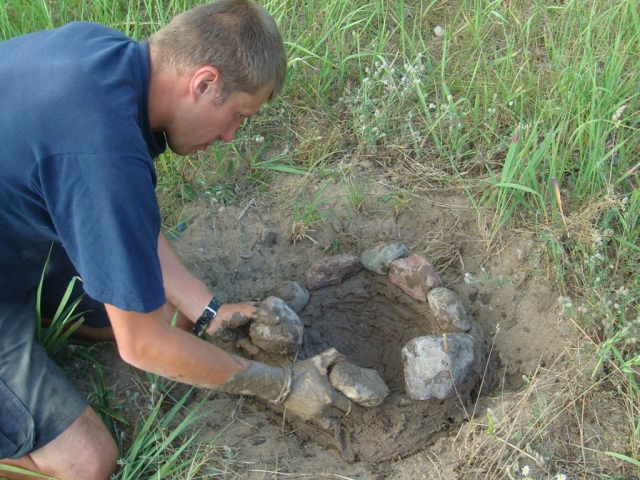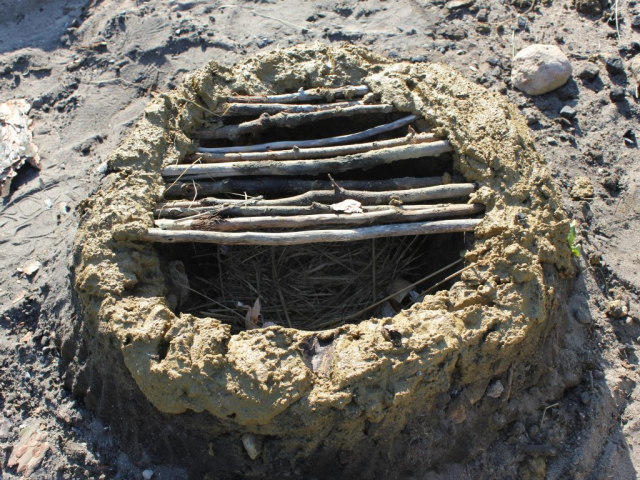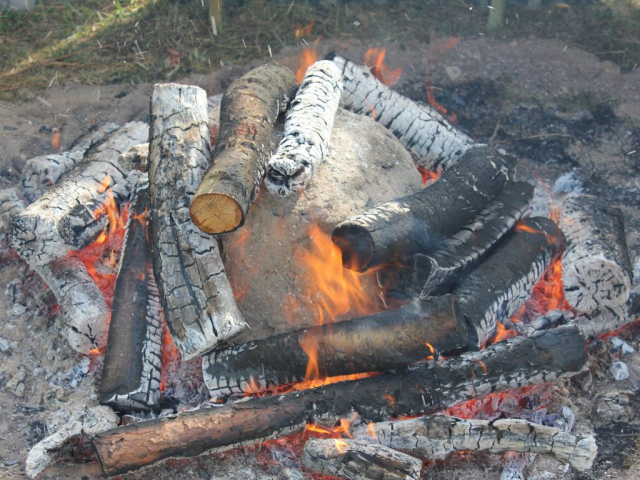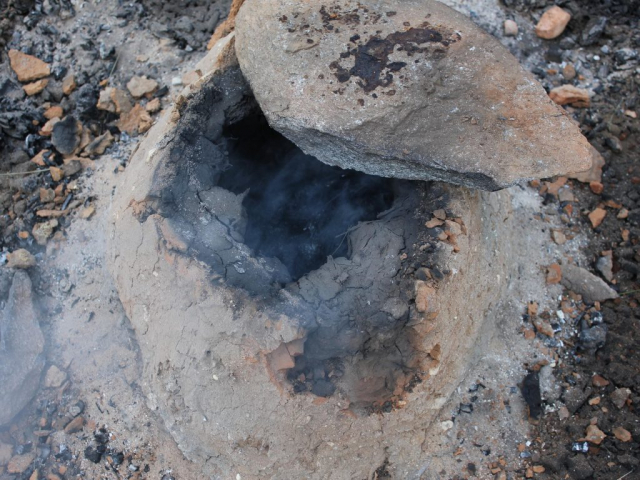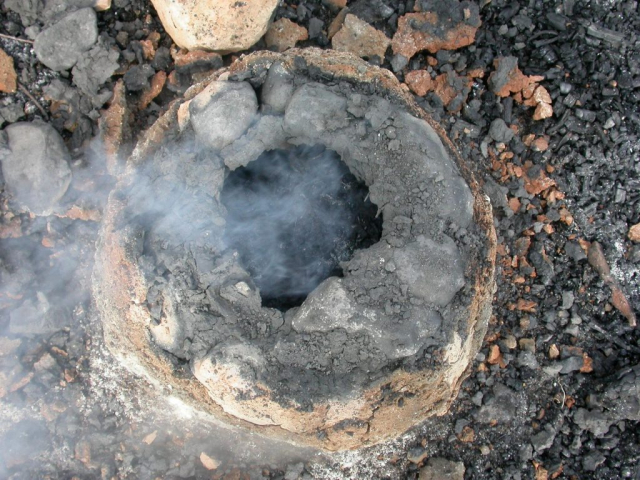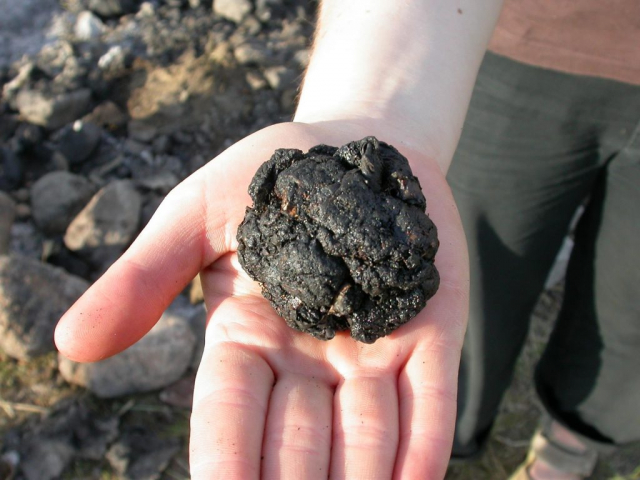Wood tar was one of the basic binding agents used in the Stone Age. It was made through the process of “destructive wood distillation” of birch bark. This process consists of heating organic compounds to a high temperature without air access in order to split it into simple compounds (Dubisz 2003). In practice this means that the raw material is roasted and the released vapour is collected by a method which cools it down (Langer 1989, p. 14). During destructive wood distillation of birch bark, material of differing consistency and properties can be made. “Proper” wood tar is formed when the temperature of the “firing” reaches above 220-280 C (Kośko, Langer 1986, p. 589).
Starting from the Neolithic Period, pottery vessels were used in the process of wood tar production. Two methods were used: One-vessel and the two-vessel methods (Kośko, Langer 1986, p. 589, Todtenhaupt, Kurzweil 2000). Both techniques require the digging of a pit and placing the vessel(s) filled with birch bark into it. The vessel(s) are sealed with grogged clay and roasted for a few hours. Wood tar made by the one-vessel method is often tainted with charcoal (Kośko, Langer 1997). Material made by the twovessel method, where two vessels are set one on another, is much more pure and semi-liquid. The larger (upper) vessel, which contains the bark, has small holes in its bottom. The wood tar is acquired during firing by it running through the holes into the smaller vessel placed underneath the big one. In this way the material obtained is separated from the charcoal rather than being contaminated by it as in using the one-vessel method.
What kind of method could have been employed for wood tar production before the invention of pottery vessels? Recent excavation of a flint tool hafted with wood tar at K�nigsaue (Germany) suggests that wood tar was known of during the Palaeolithic as early as 40,000-45,000 years ago (Junkmanns 2001, p. 7). During the Mesolithic, wood tar was a basic binding agent used for the setting arrowheads and harpoon points (Clark 1957, p. 248, Galiński 2002, p. 312). For example, an arrow from Lilla Loshult (Sweden) with two flint microliths were set with wood tar dates to 7500 years BC (Junkmanns 2001, p. 15). Wood tar has also been identified on fragments of arrows and arrowheads found near Egozwil (Switzerland) (Junkmanns 2001, p. 15) and in Poland a perfectly preserved harpoon from Tłokowo (Sulgostowska 1997, Sulgostowska, Hoffmann 1993) has two rows of flint insertions set with wood tar. A similar find (dated to the Late Mesolithic/Early Neolithic Period) was also described by G. Clark (1957, p. 68).
Despite these finds of wood tar, no remnants of the wood tar production process have been uncovered. So far no pits, no concentrations of burnt clay, and no sand hearth lining, that could be considered remnants of wood tar production have been uncovered on any Mesolithic or earlier sites. Is it possible that during this period, a method leaving no signs in the archaeological record was in use? If so, is it possible to reconstruct it?
The following presents one such experimental technique that does not use ceramics. Its possible use during the Stone Age would have left no signs recognized today. Though no argument can prove that this method of wood tar production was used during the Late Palaeolithic or Mesolithic Periods, they may have at least been similar to this one. The technique described below has been tested several times.
The Experiment – The Kiln
The basic problem to be solved before beginning the experimental firings was to work out how to seal the kiln. Without an airtight firing chamber, the wood tar would either evaporate or (more often) the bark would simply burn away failing to produce any wood tar.
The kiln used in the experiment was built directly on to the ground (i.e. no “wood tar pits” were dug). For its construction, small (O ca 8-15 cm) pebbles were used. These were covered with a mixture of “pugging”, i.e. clay (30-40%), sand, and grass to seal the firing chamber. When dry, this “pugging” behaves like very dry sand which crumbles even when delicately scratched. Yet, it forms a solid and compact shell, resilient (in comparison to raw clay) to cracks which can form during drying or firing. As the experiments showed, a the use of proper proportions of sand and clay are very important for a successful “firing”.
After the kiln walls were sealed, their thickness was about 8-10 cm. The dome-shaped (Photo 1) kiln was 40 cm in diameter and of a similar height. The bottom of the kiln was covered with a 2 cm thick layer of strongly thinned clay, formed in a depression. The kiln opening was covered with a stone about 20 cm wide and sealed with a mixture of sand and clay. Before the “firing” started the kiln was left to dry for 16 hours, after which its interior was fired for about 30 minutes by burning dry grass and reed.
The Charge
The kiln was charged with fresh birch bark ripped into narrow strips (around 1 cm wide) of differing lengths. The kiln was filled with as much bark as possible.
The Firing
After the kiln was charged and sealed its final drying began. A fire was started about 30 cm away all the way around it and this was burned intensively for approximately 90 minutes (Photo 2). During this process no cracks of any kind which could affect the outcome of the experiment formed on the surface of the kiln. After the final drying, the proper firing started and the fire was moved directly onto the kiln (Photo 3). The kiln was fired for about 3 hours, mainly with poplar (approximately 0.5 m3 of wood was used). Again, no cracks of any kind which could allow “wood tar gases” to escape formed on the surface of the kiln. After the firing was finished remnants of burned wood and ashes were removed from the surface of the kiln and it was left for 3 hours to cool down (Photo 4, 5)(1). During this stage the kiln was “sprinkled” with small amounts of water. While cooling down, small cracks formed on the surface of the kiln.
Experimental Results
The wood tar made during the course of this experiment was strongly contaminated with charcoal and the remnants of untransformed birch bark (Photo 6). The material was very hard and resilient to crushing; even at high temperatures it retained its solid form. Heating the substance to a high temperature softened it, but did not transform it into a liquid. Reducing the temperature caused the material to harden very fast. This substance is different from the one obtained through firing with the use of ceramics. Those substances are usually at least semi-liquid and they melt even during a warm day; and as a result, they are not very useful for setting flints or points. In contrast, the wood tar obtained during our experiment is very good for such a use. Arrowheads set with it broke away much more seldom then ones set with other binding agents. The possibility of fast and simple exchanges or the resetting of arrowheads is an additional advantage of our experimentally produced substance. Such actions can be performed usually in less than a minute. Besides the wood tar collected at the bottom of the firing chamber, charcoal was also formed during the firing process. About 5% of the birch bark does not undergo any transformation. This percentage is similar to the quantities left untransformed in other experiments.
Identifying This Method at Archaeological Sites
As noted above, so far, no signs have been found on any Late Palaeolithic or Mesolithic sites for the wood tar production process, beyond the wood tar itself. No signs of burnt clay, no sand hearth lining, and no pits have been found. The experimental method presented here would probably not have left any clear signs in the archaeological record. The kiln`s construction with ordinary pebbles and the relatively few signs they showed of having been burned, would probably suggest to an archaeologist that they were simply the remnants of an open fireplace. What would have happened to the hearth lining? An additional test was performed to check the quality of the lining after firing. Fragments of the clay and sand lining were placed in water, where most of them dissolved within 5 minutes. This suggests that such a prehistoric hearth lining would have dissolved in the rain leaving little or no sign of its existence.
Conclusions
The technique described here is probably one of many similar methods which may have been used during the Late Palaeolithic and Mesolithic Periods for the purpose of wood tar production before the invention of pottery. Unfortunately, such techniques would have left no clear signs in the archaeological record to identify their use. But the quality of wood tar produced by this fairly simple technique adds further support to its likely use. The wood tar material produced is a good binding agent that is extremely hard and resilient to crumbling and warm temperatures. The substance can also be transported without the use of any containers and may be used at any time after simple heating over a fire.
Grzegorz Osipowicz
[1] The kiln cannot be opened before it has cooled down (Photo 5) because this might cause the charcoal that has formed inside the firing chamber to explode.


